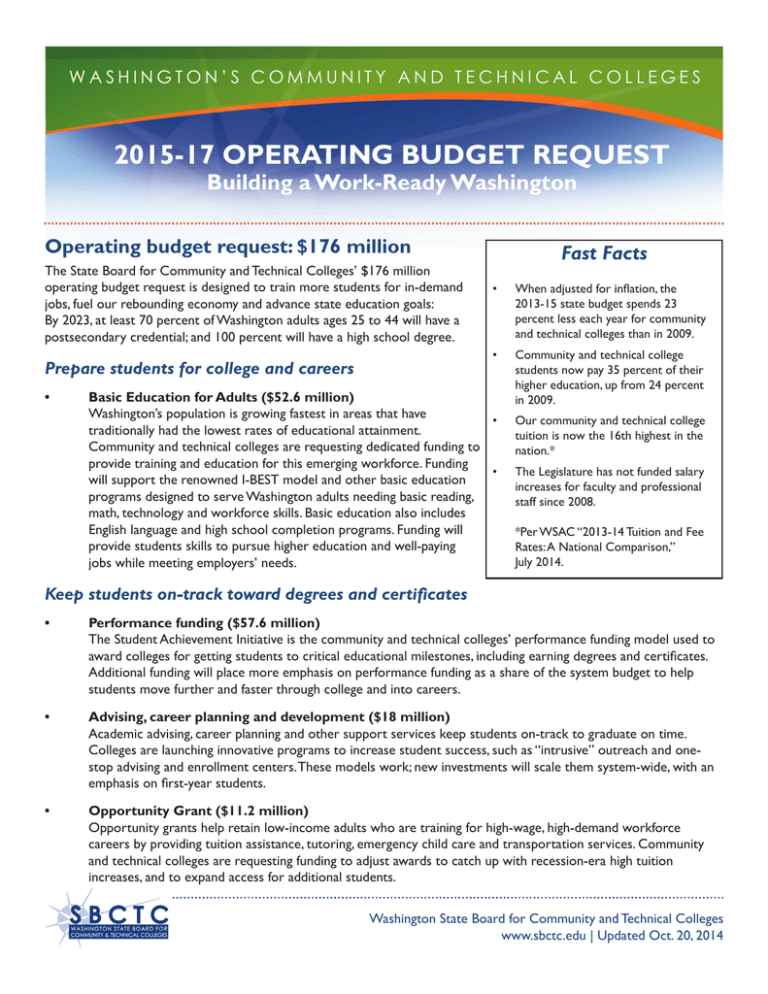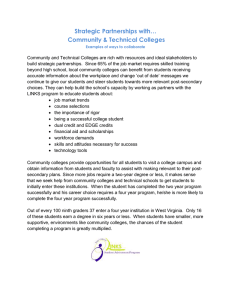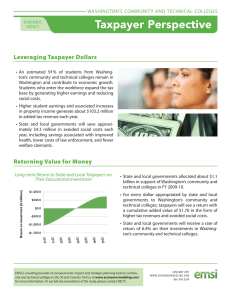2015-17 OPERATING BUDGET REQUEST Building a Work-Ready Washington Fast Facts
advertisement

2015-17 OPERATING BUDGET REQUEST Building a Work-Ready Washington Operating budget request: $176 million The State Board for Community and Technical Colleges’ $176 million operating budget request is designed to train more students for in-demand jobs, fuel our rebounding economy and advance state education goals: By 2023, at least 70 percent of Washington adults ages 25 to 44 will have a postsecondary credential; and 100 percent will have a high school degree. Prepare students for college and careers • Fast Facts • When adjusted for inflation, the 2013-15 state budget spends 23 percent less each year for community and technical colleges than in 2009. • Community and technical college students now pay 35 percent of their higher education, up from 24 percent in 2009. Basic Education for Adults ($52.6 million) Washington’s population is growing fastest in areas that have • traditionally had the lowest rates of educational attainment. Community and technical colleges are requesting dedicated funding to provide training and education for this emerging workforce. Funding • will support the renowned I-BEST model and other basic education programs designed to serve Washington adults needing basic reading, math, technology and workforce skills. Basic education also includes English language and high school completion programs. Funding will provide students skills to pursue higher education and well-paying jobs while meeting employers’ needs. Our community and technical college tuition is now the 16th highest in the nation.* The Legislature has not funded salary increases for faculty and professional staff since 2008. *Per WSAC “2013-14 Tuition and Fee Rates: A National Comparison,” July 2014. Keep students on-track toward degrees and certificates • Performance funding ($57.6 million) The Student Achievement Initiative is the community and technical colleges’ performance funding model used to award colleges for getting students to critical educational milestones, including earning degrees and certificates. Additional funding will place more emphasis on performance funding as a share of the system budget to help students move further and faster through college and into careers. • Advising, career planning and development ($18 million) Academic advising, career planning and other support services keep students on-track to graduate on time. Colleges are launching innovative programs to increase student success, such as “intrusive” outreach and onestop advising and enrollment centers. These models work; new investments will scale them system-wide, with an emphasis on first-year students. • Opportunity Grant ($11.2 million) Opportunity grants help retain low-income adults who are training for high-wage, high-demand workforce careers by providing tuition assistance, tutoring, emergency child care and transportation services. Community and technical colleges are requesting funding to adjust awards to catch up with recession-era high tuition increases, and to expand access for additional students. Washington State Board for Community and Technical Colleges www.sbctc.edu | Updated Oct. 20, 2014 Close skill gaps, fill jobs • Improve success in math and STEM ($10.1 million) Research shows that math continues to be a stumbling block for too many students and is a significant barrier to college completion. Community and technical colleges are requesting funding to redesign the math pathway between K-12 and higher education so fewer college students need remediation and more students successfully complete college level math. Our system is also requesting funds to expand the Math, Engineering and Science Achievement (MESA) Community College Program that provides a clear onramp from K-12 through college in high-demand STEM fields. Funding would expand the current six pilot colleges to 20 colleges across the state. The MESA program provides students the skills, knowledge and opportunities to explore technology-based careers, enter college and pursue STEM careers. • Rapid response workforce fund ($5 million) Companies create jobs where they can find capable workers to fill them. Our system is requesting a rapidresponse fund that will allow colleges to act even faster when a business need emerges in a local community. This ongoing funding will be used to provide a one-time cash infusion to colleges on an as-needed basis to update or start a program on-demand. Sustain a high-quality learning environment • Investments in faculty and staff ($21.5 million) Faculty and staff are critical to student success and serve as the system’s core resource. To maintain excellent education for students, community and technical colleges are requesting compensation increases for all staff, including funding for faculty salary increments. Community and technical colleges also request the implementation of current law requiring I-732 salary increases for faculty and technical college classified staff (an additional $27.4 million). Please also see our capital budget request: $367 million • Building 21st century facilities Campus construction projects provide the needed repairs, upgrades and new space for high-demand, high- tech programs and student services. Community and technical colleges have prioritized a list of capital projects that contribute to student success through innovative instruction centers and other student-focused facilities across the state. Several colleges are also requesting authority for alternatively financed projects to leverage community partnerships and enhance student support. Please see our companion capital budget fact sheet for details. Washington State Board for Community and Technical Colleges www.sbctc.edu | Updated Oct. 20, 2014




